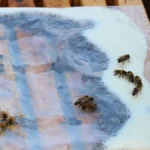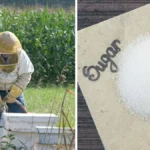You open your hive and find lots of dead bees on the bottom board. In this article, we will take a quick look at a few diagnostics you can run to find out why there are dead bees on the bottom board. Let us take a look at how to autopsy a honey bee colony. Then we look at what to do.
There are a lot of factors that can cause bees to die. Let us have a look at these and see if we can help you figure out what happened to your bees. The first to look at is the season.
Winter Dead Bees On Bottom Board
Starvation
If your bees got very cold in winter and ran out of stores, they can die and fall to the bottom board. You will find this sort of mess of lots of dead bees on the bottom board in your early spring inspections. Winter dead-outs are depressing, and with correct management and feeding, we can avoid these. Using candy boards or dry sugar feeding methods helps ensure the bees have enough sugar energy to get through the winter. This method also helps to reduce condensation in the hive as the sugar absorbs moisture.
Typically, if you find that the hive has no honey stores left, and the bees have died and fallen to the bottom board this is indicative of starvation. Sometimes you actually find the cluster of bees all stuck together, but dead. This is really sad and I always imagine my little friends running out of food and slowly fading in the cold. Definitely helps one reach into the pocket in the fall and buy sugar to avoid this.
Stored Microencapsulated Pesticides
Microencapsulated pesticides consist of an active pesticide that is coated in a polymeric substance to protect the pesticide. These are very effective in controlling pests as the activity is longer. Honeybees can however gather pollen contaminated with these microencapsulated pesticides and return this to the hive. If this is stored in the hive, when bees consume contaminated pollen stores in winter this can result in mass die-offs of bees. This is a depressing cause of lots of dead bees on the bottom board.
To differentiate between a hive that died of starvation, and one that died of poisoning from contaminated pollen is relatively easy. If there are still abundant stores in the hive, but the bees are dead, this indicates poisoning.
Suffocation
This may sound trivial, but if a hive gets buried under snow, and is unable to breathe, it will die. If the snow melts and you arrive at the hive you will find a hive with stores and dead bees. When bees suffocate, they tend to spread out a bit.

Dead Bees On The Bottom Board In Warmer Weather
There are far more factors that can cause lots of dead bees on the bottom board in warmer weather when the bees are actually flying and gathering pollen and nectar.
Mass Poisoning
In spring and summer, bees can accidentally consume pesticides. These will result in mass deaths of bees. If your hive is still alive, but there are lots of dead bees on the bottom board, you will see some bees carrying the carcasses away. Within a few days, they will clean themselves up. I normally remove pollen combs when this happens, as there is a possibility these combs have pesticides stored in them. I have had this happen twice and have tended to avoid taking bees to areas where there is a risk of pesticide application as a result.
If you suspect your hive has been poisoned, you will see a lot of bees that are dead on the bottom board. You may also find heaps of dead bees in front of the hive. Bees that have been poisoned tend to be a bit dazed and confused in the last minutes of their lives. They may shoot out of the front of the hive and sort of crash into the ground and hop around. You can see something is wrong. Normally with these forms of poisoning, the hive will have very few forages as they have all died.
Chilled Brood
Sometimes in spring, the bees can overextend the brood nest. If a cold snap occurs they have insufficient bees to keep this brood warm, and some of the brood will become chilled. This brood is called a chilled brood. Bee brood requires temperature maintenance in a very close band of temperature. If bees that are close to maturity become chilled, they can emerge but will be unable to fly. These bees can collect on the bottom board in large numbers.
If earlier stage brood was chilled it can die in the comb. In this case, large numbers of dead brood bees will be removed from the cells by workers. This can cause you to find lots of dead bees on the bottom board. These dead brood bees can be either pure white or starting to turn grey. In some cases, you will see half-chewed corpses being dropped on the bottom boards as the workers attempt to remove dead bees from the cells.
Heat
I have had hives that have died due to excessive heat. In this case, it is easy to diagnose. You will find the dead bees on the bottom board are glued to the board with melted wax. On very hot days, if a hive overheats the honey will first cascade down over the bees. This is caused by the structural failure of the combs as heat softens the wax. The bees get coated in honey and are further unable to lower hive temperature. The situation spirals out of control.
As the hive temperature increases, the wax combs actually melt and the wax drips to the bottom board sticking the cooked dead bees to the bottom board. This is a situation where you know why there are lots of dead bees on the bottom board – they are glued there.
Well ventilated hives reduce the risk of this happening.
I hope this article has helped you to determine the reasons you found lots of dead bees on the bottom board. Determining the cause of a dead honeybee colony is depressing, but necessary to avoid repeats. Wishing you the best of luck in this endeavor and please share this article if you enjoyed it.

Dr. Garth A. Cambray is a Canadian/South African entrepreneur and beekeeper with 28 years of experience in apiculture and specializes in adding value to honey. His Ph.D. research developed a new advanced continuous fermentation method for making mead that has resulted in a number of companies globally being able to access markets for mead. His company, Makana Meadery, exports honey mead to the USA where it is available to discerning connoisseurs. He has also developed technologies to commercially manufacture organic honey vinegar in Zambia for export globally. He holds a few patents globally in the ethanol industry and believes in technology and knowledge transfer for human development and environmental sustainability. One of his proudest achievements is the fact that the wind farm he started at one of his old apiary sites has essentially made his hometown carbon neutral.






